SUMMARY
This is AI generated summarization, which may have errors. For context, always refer to the full article.
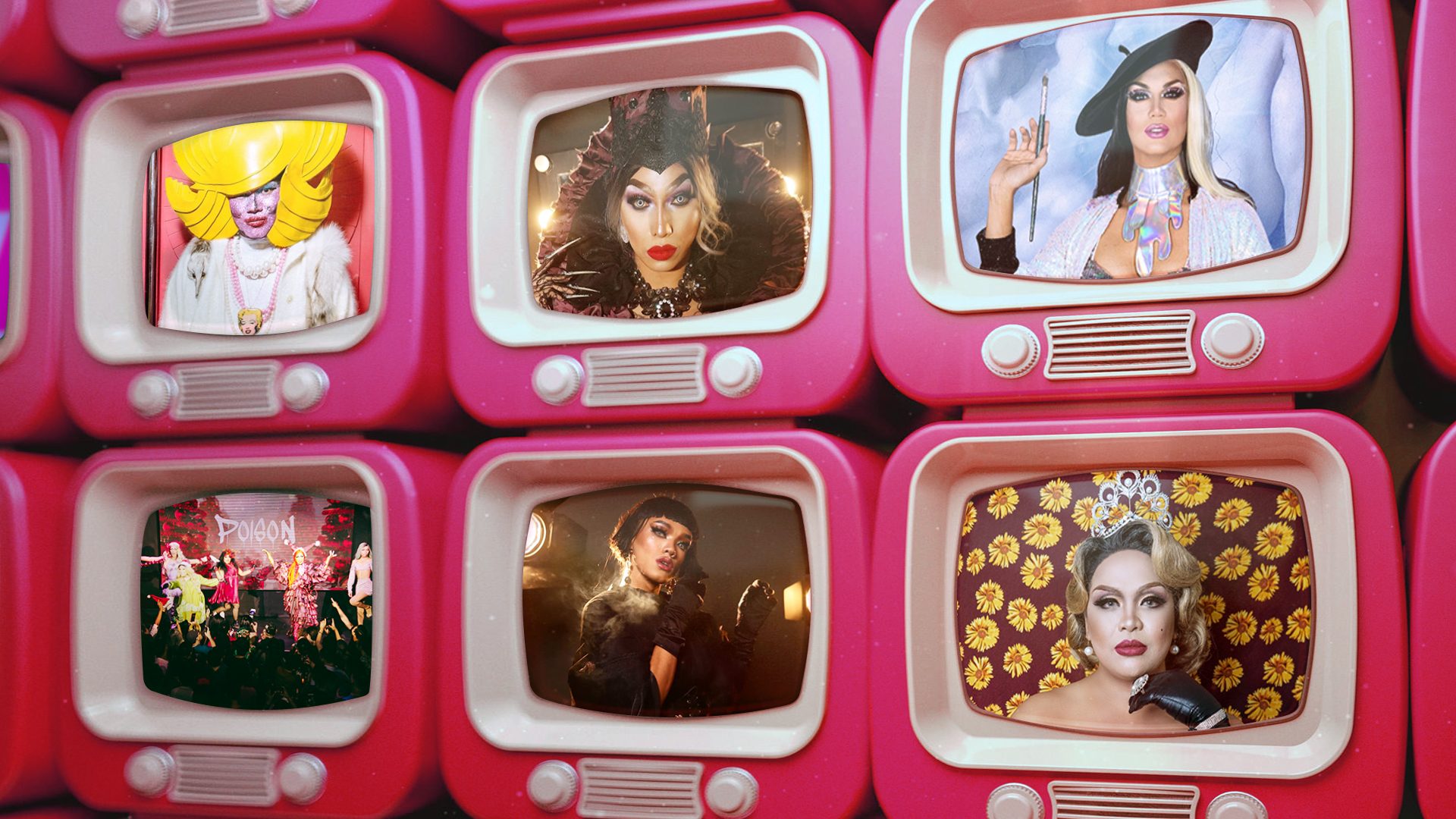
MANILA, Philippines – March the 14th was supposedly DeeDee Marie Holliday’s annual birthday extravaganza. Year after year, since 2013, she had always tried to outdo herself with these concerts.
“It was going to be a full house and the show would have been one of my bests,” the O Bar resident diva and local scene stalwart said. “However, Miss Rona was fierce and got everything cancelled.”
The next day, March 15, was the beginning of the Metro Manila lockdown – one of the world’s harshest and longest, as the COVID-19 pandemic ravaged the entire country.
To curb the rapid spread of the virus, extraordinary, sweeping measures were imposed by President Rodrigo Duterte, announcing the lockdown first in a rambling speech. A few days later, he also placed the entire island of Luzon under enhanced community quarantine (ECQ).
There was little time for a confused, panicked populace to prepare. Amid the scramble, bars and clubs – some of which are home to drag queens – were forced to shutter.
DeeDee was gutted – her plans and hard work derailed by these unprecedented and uncertain circumstances. She shared, “I have already spent thousands for costumes, props, and refreshment. I’ve finished editing the AVP. We’ve been rehearsing for over 2 weeks. Choreography was on point. The bar was supposedly fully booked and all tables and VIP sections have been sold in advance.”
“The DeeDee Experience 2020 was flushed down the drain,” the drag artist lamented.

On the other side of the Pacific Ocean, Manila Luzon was also feeling a tectonic shift amid the then-emerging pandemic.
The Los Angeles-based RuPaul’s Drag Race star was on tour and visiting family on the other side of the United States when chatter about stopping air travel was going around.
“Up until that point I was getting mixed messages about [the novel] coronavirus,” the Filipino-American performer said. “But I started to realize the severity of everything. If USA was going on lockdown soon, I might not get home.”
During that time, she said, social distancing guidelines and statewide lockdowns haven’t been implemented yet, so she made a “tough decision” to do one last show, sans the meet and greet “to avoid extra contact with people.”
“Who knows, this might have been my last live show for the rest of the year, so I collected my coin and hit it back home on the earliest flight,” said Manila, who, since then, has been sheltering in her Los Angeles home with her husband.

Even the most recent crop of Ru girls on season 12 aren’t spared by this “inopportune” timing. Vice contributor Harron Walker pointed out that touring or appearing at major events such as DragCon or any of those lined up for June, Pride Month, will likely be cancelled. While the season was airing, local queens who relied on weekly viewing parties wouldn’t be able to mount those.
Among efforts to try to curb a mounting case count and death toll, social distancing measures and stay-at-home orders have predictably caused economies around the world to go into free fall.
Even as restrictions are gradually lifted to jolt the slumbering economy awake, the fates of many so-called “non-essential” establishments hang in the balance – drag venues included. (READ: With lockdowns in place, small restaurants worry about staying afloat)
“It’s hard to overstate the impact of the current pandemic on our industry,” wrote Miz Cracker (also a Ru girl) in a thinkpiece for Slate. “In a community where even the luckiest often live paycheck to paycheck, this sudden shutdown is having devastating effects.”
With no gigs (in clubs or company events), no tips, and no end in sight to this crisis, drag artists seem to face an uncertain future.
“It will take a while before we open up, or if we will, ever again,” DeeDee said, musing on the fate of clubs in a city that was under the ECQ – and as of June 1, general community quarantine (GCQ).
But the plague is no death knell for the drag community.
Drag Race’s 12th season finale, for one, was shot remotely, yet it was fabulous and star-studded as ever. Exceptional circumstances called for extraordinary workarounds with “innovative technology that highlights the creativity of the queens.”
Newly crowned winner Jaida Essence Hall, describing the experience, tweeted, “After so much this season my sisters and I all were a part of a finale unlike any other. And it was a success. I think that if ever there was a time for ‘Best Friends Race’ this was the year. Thru all of what the world has been going thru [Drag Race season 12] has been there as a light, and brought so much joy into the homes of so many people who have been down or just going thru it.”
“I can’t imagine how it would have gone had we been each other’s enemies instead of friends. The love and positivity is what people have needed [through] this pandemic,” she added.
While sheltering in place, a lot of these performers have been turning to homebound audiences, livestreaming their shows on popular social media platforms.
‘Heel forward’
As physical spaces – once booming with raucous life – have remained shut, these artists painted their faces and put on glamorous outfits once more, taking to virtual stages to try recreating the experience of a live show.
“A lot of industries have been severely impacted by the pandemic, and I am somehow still thankful that the drag scene can still find a way to thrive and exist even if it’s only in social media,” said Eva Le Queen, the matriarch of entertainment company Drag Playhouse PH.
“If I were to be optimistic, since everyone has more time to spend on social media, it also allows more […] drag queens to host online shows in the comfort of their own homes,” she continued.
For Eva, going the online route has widened the playing field, saying “that talent is only a matter of access.”
“Younger and aspiring queens do not always have the opportunity to be seen and perform unless they are booked by an establishment,” she said. “And avenues or events for non-commercial and alternative forms of drag are not very common.”
“Whether you are a starting baby queen or a big-shot prima donna in a club, we are all on equal footing online.”
Around Labor Day, Eva’s company, together with some Manila-based DJs, co-produced Salute: a tribute show meant to “bring the nightclub party we’ve all been missing right at the comfort of your own home.” This was only one among several shows they intend to stream.
They had drag queens, DJs, and even live singers. Streaming on Facebook Live, these shows would run for hours on end – barring the occasional glitch or interruption. The comments section were open, and they encouraged everyone to fix up a drink – somehow simulating the feeling of a night out in the club.
“We are also able to bring the art of drag to people who do not go to clubs,” Eva added. “We now have access to a larger market – a market that has lots of time to spare on social media.”
“The truth is, a lot of drag enthusiasts are also people who do not party. We have our regulars in the club but most of them are there for the drinks and the nightlife. We owe it to the club scene for bringing drag to the community but it doesn’t have to stop there.”
DeeDee Holliday was one of the queens on the roster. She was relishing her return to the stage, albeit a virtual one. This didn’t stop her from fiercely belting out – by lip sync – the Moulin Rouge version of “Lady Marmalade,” switching between blonde wigs from her arsenal.

“I support what our sisters are doing in order to thrive and survive. There’s no shame in that,” she said about this unusual arrangement, adding that some of these shows are also fundraisers for frontliners and other vulnerable people.
“Some of my sisters are doing online games as part of their routine and it’s a riot,” DeeDee continued, also sharing that her home base, O Bar, has provided her sister queens with access to their social media channels.
“Others are doing make-up tutorials. Some go live on Facebook just to talk to people and whatever beverage they are drinking while doing this is just a minor detail of the act. Hundreds are tuning in to support our local drag performers,” she said.
Mrs. Tan, an up-and-coming queen who has drawn attention for her thought-provoking craft, is weathering the pandemic with her grandparents in Batangas. While away from the locked down metropolis where she has staged many of her shows, she is turning it up online instead.
For Salute, she donned an all-white ensemble and performed with the lights dimmed around her (save for a DIY spotlight) to an upbeat remix of Deborah Cox’s “Nobody’s Supposed to be Here.” Because many of her selections are “quirky and nasa ilalim ang meaning (with latent meaning),” it was meant to evoke a concept in vogue: social distancing.
“It gives you a different experience yet it’s the same person,” Mrs. Tan spoke about digital drag, however adding that a myriad of limitations make it wholly different. “You can’t really compare it with live shows.”
As performers, they try to work within limitations and strive to capture the exhilarating energy of a live show. She said, “You get to look at the camera and connect with your audience the best way you can. Just like any other live performance, you feel the moment.”

Performing in drag on screen isn’t exactly uncharted terrain. The widespread popularity of reality competition series RuPaul’s Drag Race is a solid testament to this.
“Our audience already watch us on screens on Drag Race so it’s an easy transition. The overall experience is different but we are still going to be serving drag,” Drag Race alumna Manila said.
“In a way I think we drag queens have a ‘heel’ forward on other artists,” the Fil-Am queen added, explaining: “We are used to creating from nothing, making costumes from things we find around the house, using our imaginations to create illusions.”
“And we are in on the joke; this towel on my head isn’t really long, luxurious, bouncy blonde hair,” she continued. “So unlike any, say, famous actress without her hair and makeup trailer or her script or a her movie sets, drag queens can do it all by themselves.”
Known for serving iconic lewks like a pineapple dress and her “Eleguence After Dark” silver gown, the fan favorite gets to stage her signature routines instead in an unconventional, more lounge-y way.
“My audience got to know the real me watching me on TV. It’s just another peek into my real life – my very real life where I lounge around in full make up and giant wigs and sparkly heels, binge watching Drag Race,” Manila told Rappler.
Together with her husband, she joined other artists in the streaming concert series Digital Drag Fest, with shows like At Home with the Luzons and The Joy of Painting.
“My digital drag shows are nothing like my live shows, but it still has the connectivity of it being a live moment,” she pointed out, as these shows happen in real time, with limited room capacity and a cover fee of $10 – recalling the “intimacy and exclusivity” of a local drag show.
“It strips away a lot of the fantasy that comes with a live drag show,” Manila said. “In its place, you get a real me, unedited, uncensored and just as glamorous! And best of all, you get to see me with my husband Michael [Alvarez].”
Elsewhere in the United States, New York-based queens West Dakota, Juku, and Magenta have taken their Oops! series to Instagram Live, calling it the Social Distancing Edition.
Instead of their usual haunts in Brooklyn, they’re maximizing the vertical screen format on the platform’s native livestreaming service. Occasionally, the show would even feature guests from other countries.
“I think [the decision to lock down the city] sent a lot of people spiraling,” West Dakota told Vogue. “It is easy to feel defeated by all of this, but, if anything, it is opening up new possibilities with what we can do for our platforms and for drag.”
But drag – as much as it’s a burgeoning artform – is still a business and financial lifeline for some queens.
“It is really cool that we are able to give a platform to people where this might be their only income for a while,” Dakota added. “This is our main source of income, and it is a scary time for people who work in the service industry who work in nightlife. This situation has highlighted how precarious our work is in this world.”
Tip your queen
“Drag is a zero-margins business that requires constant and extravagant investment for performers struggling to keep their audiences and gigs,” also wrote Drag Race season 10 and All Stars 5 contestant Miz Cracker.
It can be financially draining to breathe life into those larger-than-life personas with wigs, makeup, costumes, and accessories.
“We normally say that Drag is an expensive hobby,” claimed Eva Le Queen. “Many queens are already running low on resources and the shops where we normally get our stuff is not available.”
When the ECQ was abruptly foisted on everyone, a lot of drag paraphernalia were left stored inside the clubs, Eva said, adding, “This unavailability of resources limits drag queens to fully showcase their art and talent online.”
Before coronavirus, drag performers get paid when they’re booked by a venue or at some event – but it’s the tips that matter more, especially in covering related expenses.
While online festivals like Digital Drag Fest have used the StageIt virtual platform that allows them to charge admission, others only recommend tips through money transfer channels.
Salute, for instance, had a prominent ticker at the bottom of the screen displaying a queen’s GCash, PayMaya, PayPal, and bank accounts. Oops! also used Venmo, a US-based payment service.
“I think [tipping] is a good practice because these queens still spend money even if it is an online show and they should be paid for it,” said Candy Whorehol, a DJ at queer hotspots Today x Future and Nectar, who happens to do it in drag.
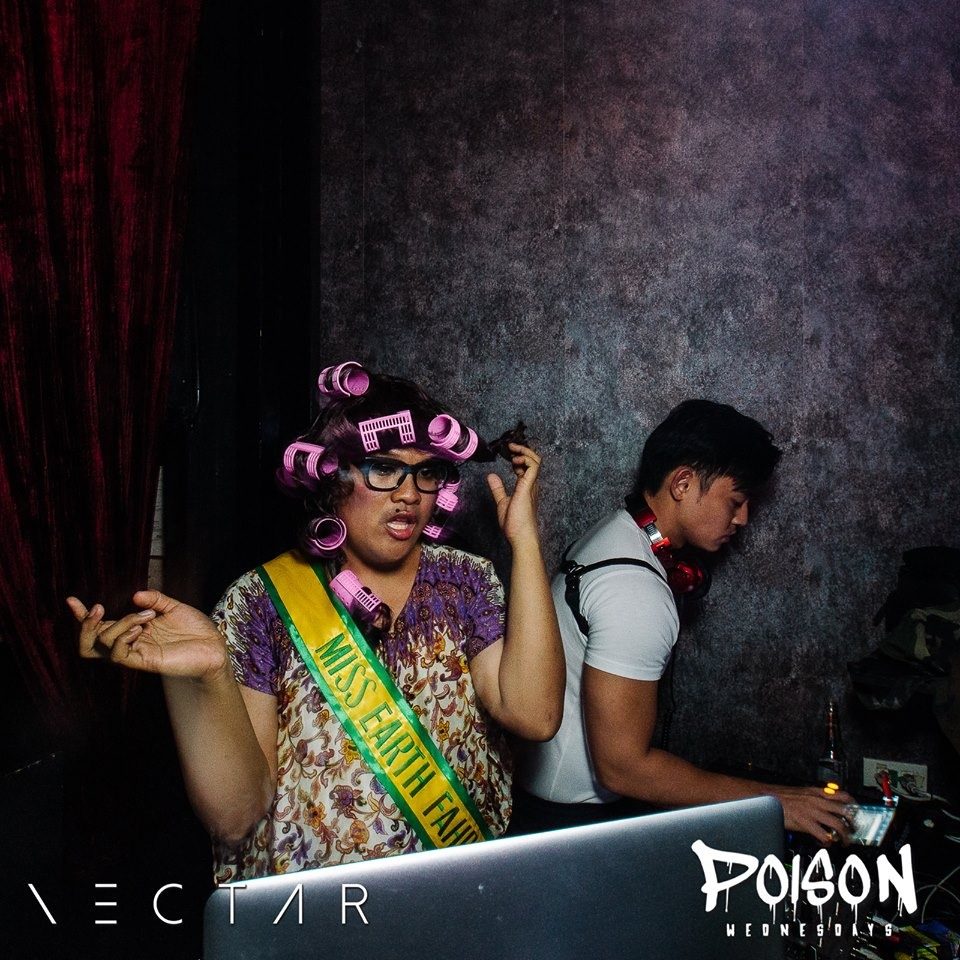
Drag, as an occupation, isn’t lucrative or suitable for a work-from-home arrangement, compared to graphic design or editing jobs, argued Candy.
Like many in the local scene, she is employed full-time; here, it’s still common among performers here and elsewhere to report for a day job.
Many drag artists like Candy and DeeDee have been maintained and supported by their companies during the lockdown, even as offices and bricks-and-mortar shops remained closed.
“The company is still retaining me, thankfully,” Candy, who works in retail, shared. “Some of our stores are open now, so work for my other workmates have resumed. But I have to stay at home since there’s no public transportation, so there is no way for me to report to work.”
“Fortunately, we are being compensated while this is happening,” shared “corporate queen” DeeDee, who works in finance. “My employer is generous, but I understand that it can’t go on forever.”
Persistent imbalance
“For some drag performers, these livestreamed spectacles are an essential means of staying in touch with their hard-won fans.” also wrote Miz Cracker.
For Manila Luzon, performing online is a way of giving back to the community that have embraced the queens and their craft.
“I know it means so much to the fans,” she said. “They give me so much life! I look forward to finding new ways of entertaining my fans around the world! If they’re old enough, they’ll know to have a cocktail or glass of wine when they tune in!”
Yet not every drag artist is lucky to have a decent-paying full-time job, much more a company that can somehow afford to stay afloat during an economic downturn.
There are even those whose occupations depend on social proximity, and at this juncture, mass gatherings are still risky business.
“For others, finding work online may make the difference between paying the rent this month – and losing everything,” Miz Cracker added, describing the predicament of full-time drag performers in the US who are less lucky.
“Drag performers, just like most entertainers, don’t usually get regular salaries or sick leave. So we are very economically vulnerable at a time like this,” New York-based drag queen and “her-storian” Linda Simpson told Them.
Some of them have thus resorted to online streaming as a stopgap, to tide them over while under quarantine.
But some, already less advantaged to begin with, have performed in drag “to survive,” as a 2017 Vice feature put it. Consider, the lolas of the Golden Gays. (READ: ‘Golden Gays’ looking for a home)
Barely scraping by to maintain a sturdy roof over their heads, the pandemic has made these elderly gay men struggle to put food on their tables and shelter in place amid the virus threat. Some – even pre-COVID-19 – have been staying on the streets. (On April 2, one of the Golden Gays, Lola Rica, had reportedly passed away “due to health complications”)
Thankfully, several individuals and groups who have initiated donation drives for the lolas were able to raise money for their rent, groceries, and other necessities during these more difficult times and the uncertain months ahead.
While livestreaming indeed opened up opportunities for performers – seasoned and budding ones alike – some imbalance persists among them in this current platform.
“Harder siya,” Mrs. Tan argued, “Mahirap siya kasi di siya equal footing sa lahat.” (It’s harder. It’s hard because we’re not all on equal footing.)
Going online – especially with lagging internet standards in this part of the globe – doesn’t necessarily make things easier for everyone. Mrs. Tan cites, among others, queens who have no online payment channels, low-quality cameras, or fluctuating connectivity.
“I can’t go on a live show without a stable internet connection. It’s gonna be interrupted, so ako umaasa ako ngayon sa mga shows na pre-recorded,”she explained. (I currently rely on pre-recorded shows).
Mrs. Tan also expressed concern for queens with a less than substantial following – a worry that has been transplanted from the live setting to online shows.
“Imagine in a club, having ten queens tapos ‘di naman lahat ng queens na iyon same ang fanbase and following sa social media,” she posited. (Imagine in a club, having ten queens and not all of them have the same fanbase and social media following.)
“If you’re doing a solo live show, it’s gonna be different. Paano kung kaunti yung manood sa akin or yung manonood sa akin won’t tip me?” (What if only a few people will watch me, or those who would won’t tip me?)
Well-known and rising queens would normally share the billing, such as in the shows mounted by Eva Le Queen’s Drag Playhouse.
This model for digital shows – akin to one cited by Miz Cracker in her thinkpiece – would potentially “build a large enough paying audience for a single streaming show that every participating queen can pull a significant base pay.”
However, Eva also worries about the market getting oversaturated, as “anyone can do it.”
“There may come a time that people may stop giving tips since it’s not compulsory in order to watch the queens perform,” she added. “Imagine all the efforts and talent you’ve invested and get nothing in return.”
Eva intends to address this pitfall with “more structured and curated quality content,” adding, “That will allow us to ask for premiums and be able to sustain ourselves through digital shows.”
Queens have to push the limits of their imagination, innovating with the digital tools at their disposal.
Observe this clip of a zany lip sync number from the Oops! girls, recorded by Vice contributor Harron Walker:
icymi: @HaraJukujukuu + West Dakota took oops! to instagram live last night (venmo tips to oopsgirls) pic.twitter.com/LE1qyOXCRA
No warm bodies
With online shows the live experience can’t be entirely replicated, but they ought to be decent approximations. This includes interaction with an audience, which is core to the experience of a drag performance.
“Drag shows have always incorporated audience participation,” said DJ and queen Candy Whorehol. “As a drag performer, you also get energy from your audience while performing.”
How is this possible online?
Some events, such as Nectar’s Poison Wednesdays (and its Drag Cartel contest), have momentarily morphed into Vaccine Wednesdays, a party held on Zoom.
Although the videoconferencing platform can allow a semblance of social interaction in this age of isolation, it’s still a little tricky on the part of the performer.
For Mrs. Tan, video even dilutes the intensity of her performance.
“Feeling ko, mas maganda yung performances ko live compared sa videos kasi, for me, nababawasan ng power. Iba yung connection kapag sa video,” she said. (I feel my live performances are better because video reduces its power. Video has a different sort of connection.)
Onstage, queens often pace the entire span of the stage, commanding and captivating them with all sorts of emotive gestures and reveals. Sometimes, they’d let the audience be part of a number or a joke for a few moments or its entire duration.
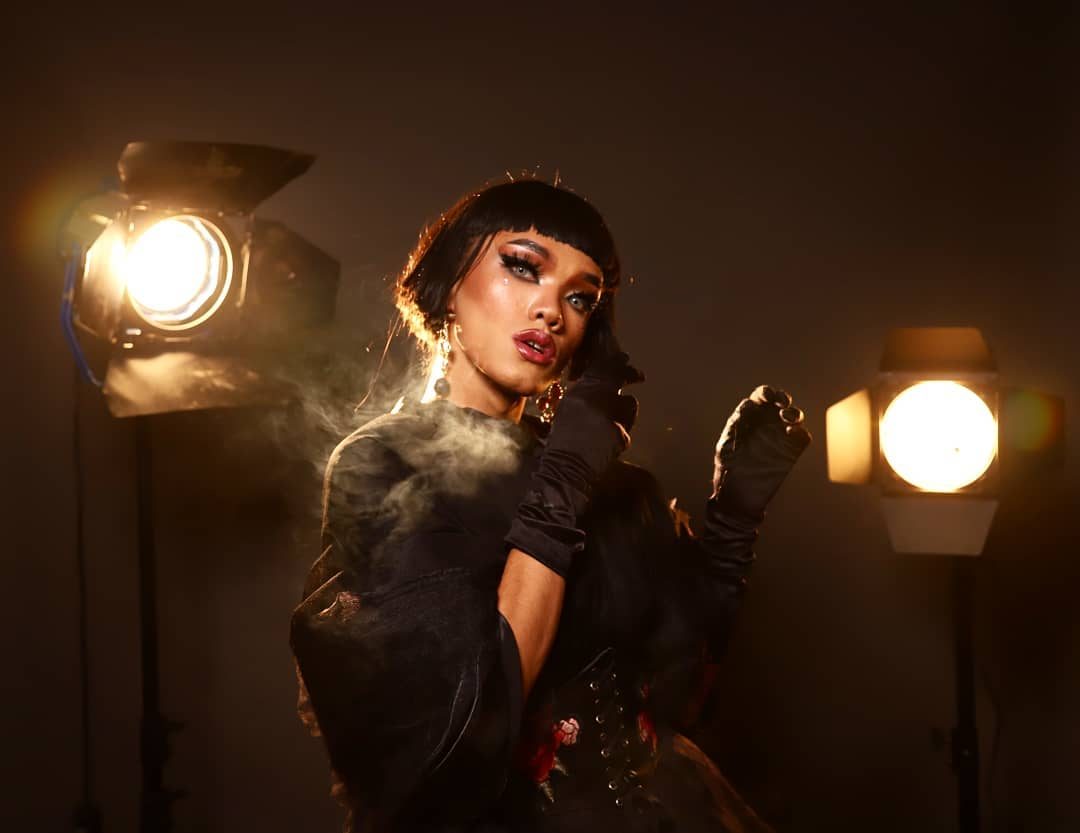
Online, Mrs. Tan argues, it’s harder to “contain” audience focus. Attention spans can be so short, that it could diffuse with a simple switch to a different browser tab or app.
“‘Di mo sila pwedeng lapitan sa kani-kanilang mga tahanan at sabihing, ‘Hey, watch me,’” she said. (You can’t physically approach them in their houses just to tell them, ‘Hey, watch me.’”
“Ang mahirap kasi sa live artis minsan humuhugot ka rin ng energy sa audience mo and it’s hard not to see or feel the audience during the time that you’re performing,” she added. “So, how do I make myself feel happy or saan ako huhugot ng energy, given that the situation right now is very depressing?”
(The tricky thing about live art is sometimes, you’d need to draw energy from your audience, and it’s hard not to see or feel your audience during the time you’re performing. So how do I make myself feel happy or where will I get that boost, given that the situation right now is very depressing?)
“So lakasan din siya ng loob at patatagan ng psyche as an artist,” Mrs. Tan said. (So it’s a matter of finding that inner courage and strengthening your psyche.)
“The warm bodies you interact with in a club will always be different,” said DeeDee Holliday. “Personally, I still feel that a live audience is so much better, but we have to work with what we have right now.”
Safe spaces
For some queer people – drag artists and fans alike, the closure of clubs has also meant losing refuge.
“It was one of my biggest worries when the quarantine started: that queer kids would lose so much of what gives them a sense of acceptance and strength,” Paulo Castro, one of the hosts of Nectar’s Poison Wednesdays party series, told Rappler.
They regularly organize Drag Cartel, a competition for both aspiring and practiced artists. “We take care of a lot of drag kids,” he pointed out. (READ: What Christmas is like for the drag queens at Nectar)
“There are also a few issues of some drag queens who are not open to their families,” observed Eva Le Queen.
Indeed, there are queer and trans people who aren’t entirely out – sometimes in varying degrees, or only to certain people. It’s such a complicated attitude toward outness, that some LGBTQ+ drag artists confine their craft to the performance venues.
Speaking from her own experience, Eva tried to illustrate the point: “My mom would probably love to see me play the guitar or do some dance videos but will probably have an entirely different reaction when she sees me in full make up, with a huge wig, humongous breasts, and in a woman’s clothing. You know what I’m saying?”
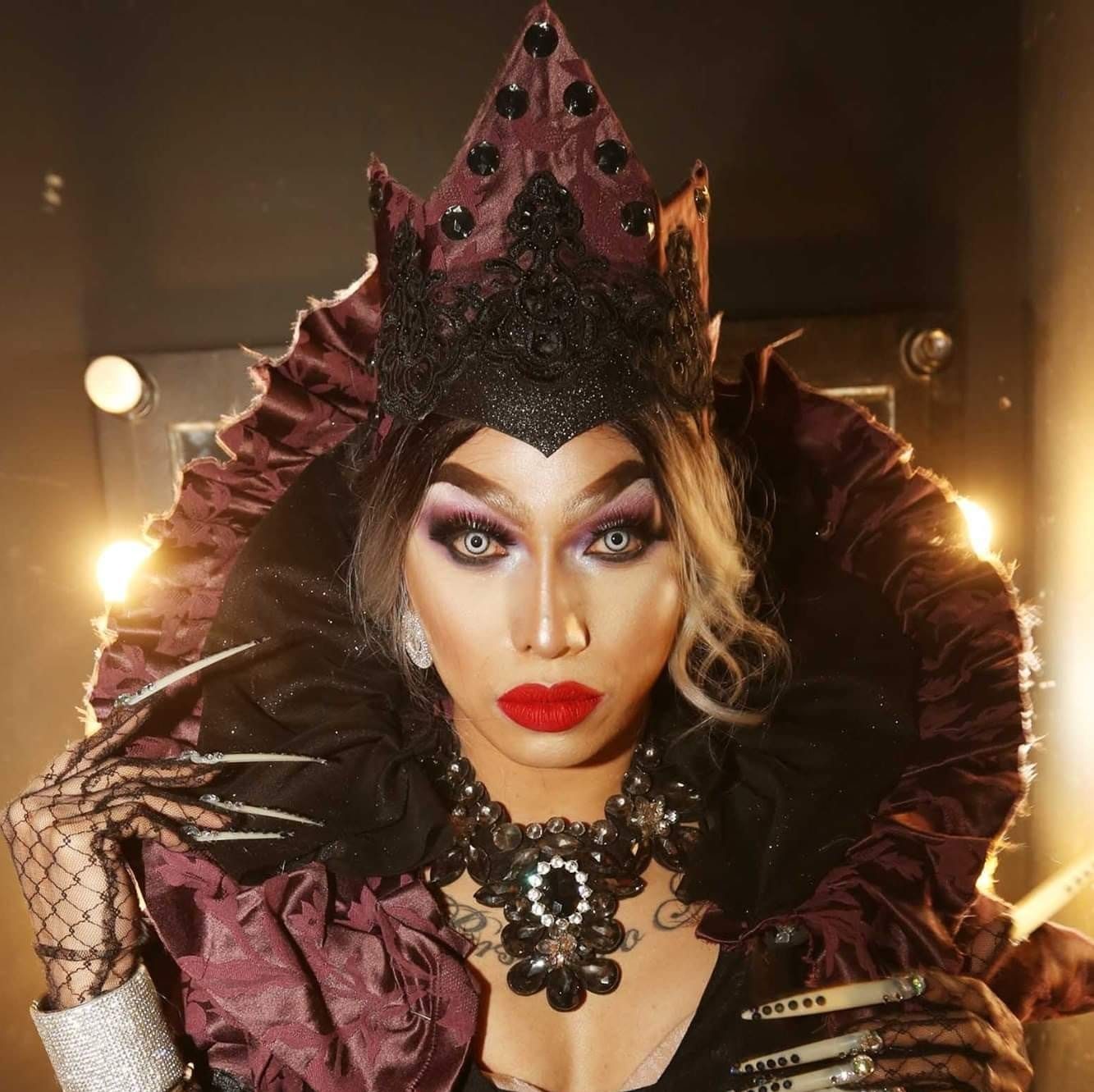
These nightclubs – more than a place for hedonistic pursuits – has fostered relationships among the LGBTQ+ community. Here, queer people shape their identities around others who share their experiences.
But some drag queens aren’t out to their own families, and some don’t accept them at all, which makes the current circumstances even more taxing.
Eva offered an explanation as a matter of fact: “Drag has always been seen in a different light by heteronormative society, especially [with] the generation of our parents.”
For some drag queens, families are chosen, and these are in the nightclubs, their home.
Yet without a physical haven, the community can still to turn to each other in cyberspace.
“With the lack of physical spaces, we just have to stick to each other, metaphorically,” DeeDee suggested.
“I always get in touch with my friends,” she said. “I check their statuses online to see if they how they are doing. If they haven’t posted anything at all, I reach out. Personally, I say what I feel on my social media accounts to let everyone know how I’m doing.”
For Mrs. Tan, social networks have created bridges for the community, noting that some groups were created only during this time: ”out of boredom, out of finding that safe space… that space kung saan pwedeng kang magkuwento (where you can share your stories).”
“For someone na walang kasamang beki na nakakaintindi dito sa bahay, (who doesn’t have a gay companion here at home who gets them),” she added, “it really helps me to share my stories, to hear other stories, and make your advocacy come across.”
“We need to stay vigilant and vocal online. We need to check on each other,” proposed Castro, who said that it’s especially vital to look into those who are alone and psychologically vulnerable.
“I always say check on your friends, especially those you know live alone,” he said. “We’re all online now, so if you see someone whose mood changes, please don’t be afraid to ask.”
For Manila Luzon, it’s a matter of finding a haven among supportive people, even in unexpected places. “Maybe society has moved forward enough that we’re ready to take the training wheels off and make that safe haven wherever we are, especially when you’re home with family,” she mused.
“Although we may not have the physical space for us to celebrate who we are, our LGBTQ+ community has a very strong sense of solidarity and culture,” Eva also said.
Castro remains hopeful that solidarity – which has been cultivated in these spaces – would encourage people in the community to look after one another.
“I’m hoping all those years of spreading love and positivity inspires them to take care of each other, even without physical contact,” he said.
“Support each other,” he urged. “When you see queer artists sharing their art online, give them messages of support. Reach out. Share their beautiful work. If you can, tip them. Most importantly, don’t forget to tell people you miss and love them. That will never not make someone’s day better.”
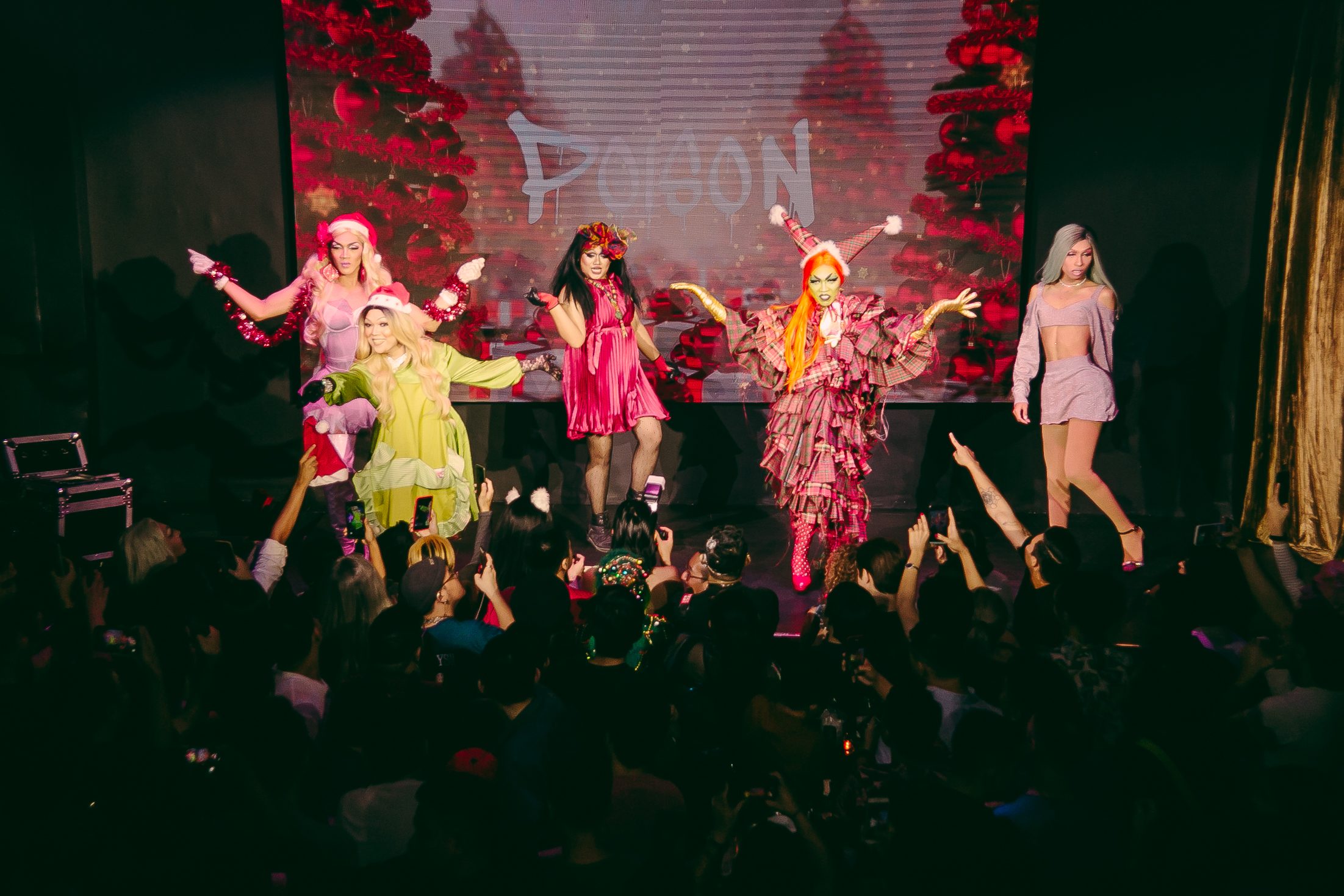
Zoom party Vaccine Wednesdays stays as a channel to check up on each other, catch up, and be entertained – just like the pre-coronavirus days.
Aiming to “#KeepDragAlive,” Drag Playhouse has also been actively seeking out ways to connect to fans on Instagram and Facebook with smaller-scale events and activities. “This allows us to reach out to our lonely brothers and sisters who needed a dose of laughter and relevant ‘chika’ that only your flamboyant, gay barkada can give,” said its matriarch, Eva Le Queen.
For her, these online shows in itself can also remind people of a community that has their back.
“Now more than ever, visibility matters. Knowing that you are not alone and that we will always have one another has always been the cornerstone of LGBTQ+ pride,” Eva said.
Doing what they love
Options remain limited as long as the COVID-19 threat persists, so it seems that broadcasting online is the way to go for these drag performers.
“Unless we find a cure and vaccine soon, this seems to be the way to keep performance arts alive,” Castro said.
For him, continuing to perform online arises from a sublime, abstract need for self-fulfillment: “If you yourself are a performer, you might actually need this more than others.”
“Artists need to perform,” Castro added. “We need to express ourselves through our art. In as much as we do it for others, we perform for ourselves, too. We need to keep performing. We need to keep creating. No matter what comes, artists will always find a way to create.”
“I think performing online also has a dual purpose for these queens,” said Candy Whorehol, echoing the point. “They are able to practice and not remain stagnant during this lockdown.”
For Mrs. Tan, online shows spring from an artist’s need to create art more than anything else – something which they would sorely miss without a stage – whether virtual or physical.
“Most of the drag performers are passionate about what they’re doing more than making ends meet kasi sa totoo lang… ang drag, as of the moment, ‘di niya kayang i-support ang bills mo and everything unless may iba kang sideline or raket,” she admitted. (To be honest, drag, as of the moment, can’t pay your bills unless you have a sideline.)
Mrs. Tan said that for performers some like her, it’s really just something they miss doing, especially if they’ve been doing it regularly. It also eases their misery during these difficult times.
“Feeling ko (I feel) it’s [really] more of doing what they love,” she said. “It makes them happy. It creates a sense of identity and an escape from who they really are kasi (because) you’re making another persona, and making that persona alive is life-changing.”
Mrs. Tan sees her drag persona as an “escape,” saying: “Nabibigyan niya ako ng (She gives me) certain power and confidence. That feeling of power from your oppressed state is something.”

Meant to entertain
Drag, like any artform, can be a shining beacon in these dark times.
“We are drag queens. We are meant to entertain (and offend your senses sometimes),” said DeeDee Holliday. “It is our little contribution to society. Making people feel better and forget the about the difficult situation we are in will always be a worthwhile effort.”
Distraction is welcome at a time when the entire world is bombarded with bad news and rising, discouraging numbers. As the public does their part in containing the virus threat, some entertainment does enough to ease their weary minds.
With online shows and gatherings, queens have also used their platform to pool resources for more vulnerable sectors – from frontliners to their less fortunate sisters in the Golden Gays. They continue to work with advocacy groups, such as those for people living with HIV.
“Is it going too far, though, to suggest that drag queens are actually helping people survive out there? Miz Cracker wondered. “After all, it’s not like they’re medical professionals on the front lines – nor are they really even making public service announcements.”
“For me, drag is a responsibility,” Oops’s Juku told Vice. “And I don’t mean that like it’s necessarily a bad thing, more that it’s our responsibility to bring light to subjects like these, to let everybody know that we’re gonna be okay.”
“We can laugh. We can have a good time, even if that means having it in the comfort of our homes for a second,” she added.
Even in this calamity, the art of drag can thrive – as it always has.
“One of the wonderful things about drag is that it is borne out of adversity, from people being creative about negative circumstance that is hellbent on keeping us from thriving,” BenDeLaCreme told Them. “I still believe that drag performers are the perfect people to come up with ingenious new ways to connect with each other… adversity is what breeds creativity, and that’s true universally among artists, and I think specifically and more fiercely among queer artists.”
“Times are trying. Things are more challenging,” said DeeDee Holliday, remaining optimistic. “One thing I’m sure of: the [LGBTQ+] community will survive this.”
“We’ve been through so many difficult situations but we always manage to thrive,” she told Rappler. “To some, living their truth every day is a struggle. We can fight this. We will rise up. After all, we are called queens for a reason.” – Rappler.com
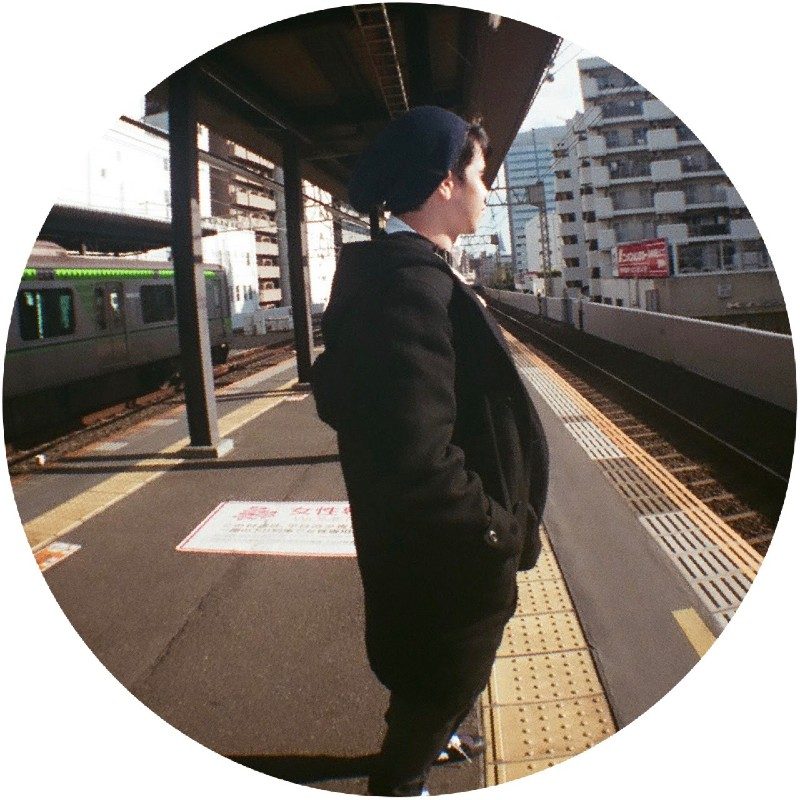
Paolo Abad is a film/television editor and motion graphic designer. He is also a self-confessed concert junkie.
Add a comment
How does this make you feel?
There are no comments yet. Add your comment to start the conversation.